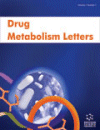- Home
- A-Z Publications
- Drug Metabolism Letters
- Issue Home
Drug Metabolism Letters - Current Issue
Volume 14, Issue 3, 2021
-
-
The Catalytic Activity of GSTM1 In vitro is Independent of MAPK8
More LessBackground: Glutathione S-transferases (GSTs) are phase II metabolic enzymes crucial for the metabolism of electrophilic drugs. Additionally, several GST isoforms are involved in protein- protein interaction with mitogen-activated protein kinases (MAPKs), modulating apoptosis pathways. Methods: To assess the potential change of enzymatic activity, we performed a GST enzyme assay with human recombinant GSTM1 in th Read More
-
-
-
Micronutrient Deficiency in Pulmonary Tuberculosis - Perspective on Hepatic Drug Metabolism and Pharmacokinetic Variability of First-line Anti- Tuberculosis Drugs: Special Reference to Fat-soluble Vitamins A, D, & E and Nutri-epigenetics
More LessAbstract: The liver plays a crucial role in endogenous metabolic activity and homeostasis of macro and micronutrients. Further, it acts as a metabolic hub in mammals, where the ingested food-derived nutrients and xenobiotics or drugs are metabolized for utilization and/or excretion through its enzymatic and non-enzymatic machinery. Nutritional deficiency, one of the major public health problems, is associated with Read More
-
-
-
Physiological and Pathophysiological Role of Cysteine Metabolism in Human Metabolic Syndrome
More LessAbstract: Cysteine is one of the major intermediate products of cellular amino-acid metabolism. It is a semi-essential amino acid for protein synthesis. Besides, it is also employed in the regulation of major endogenous anti-oxidant molecule i.e., reduced glutathione (GSH). Further, it is a precursor of multiple sulfur-containing molecules like hydrogen sulfide, lanthionine, taurine, coenzyme A and biotin. It is also one of the Read More
-
-
-
Analysis between Linagliptin and Azithromycin: In vitro and In vivo Interaction Study
More LessAuthors: Md. D. Sohel, Faisal Asif, Tonmoy Kumar Mondal, Md. H. U. Sumon and Md. Hassan KawsarBackground: Linagliptin is prescribed as a dipeptidyl peptidase-4 (DPP-4) inhibitor. Azithromycin is specified as an antibiotic that binds with 23s rRNA of the 50s ribosomal subunit, obstructing the microbial protein synthesis. Our study focuses on the drug-drug interactions of these drugs. Objectives: The purpose of the study is to understand the bioavailability and physicochemical approaches of Linagliptin and Azithromycin Read More
-
-
-
Comparative In vitro Metabolism of Enflicoxib in Dogs, Rats, and Humans: Main Metabolites and Proposed Metabolic Pathways
More LessAuthors: Josep Solà, Àngel Menargues, Josep Homedes, Marta Salichs, Maria T. Serafini and Gregorio EncinaBackground: Enflicoxib is a non-steroidal anti-inflammatory drug of the coxib family characterized by a long-lasting pharmacological activity that has been attributed to its active metabolite E-6132. Objectives: The aim of this work was to explore enflicoxib biotransformation In vitro in humans, rats and dogs, and to determine its metabolic pathways. Methods: Different In vitro test systems were used, including hepatocytes and li Read More
-
-
-
Ameliorative Effect of Acetyl L-carnitine in Alzheimer's Disease via Downregulating of Homocysteine Levels in Hyperhomocysteinemia Induced Cognitive Deficit in Mouse Model
More LessAuthors: Nisha Verma, Jeetendra K. Gupta, Krishna Kumar Varshney and Rajnish SrivastavaAims: The study was aimed at exploring the role of Acetyl L-Carnitine supplementation attenuating dementia and degradation of cognitive abilities in Hyperhomocysteinemia induced AD manifestations in the mouse model. Background: Alzheimer’s disease (AD) is a neurological disorder that is marked by dementia, and degradation of cognitive abilities. There is great popularity gained by natural supplements as the treatment fo Read More
-
-
-
s Corrigendum: Inhibitory Effect of Codeine on Sucrase Activity
More LessAuthors: Dariush Minai-Tehrani, Saeed Minoui, Marzie Sepehre, Zohre Sharif-Khodai and Tooka AavaniA typographical error appeared in the author’s name of the article entitled “Inhibitory Effect of Codeine on Sucrase Activity“ by Dariush Minai-Tehrani, Saeed Minoui, Marzie Sepehre, Zohre Sharif-Khodai, Tooka Aavani, Drug Metabolism Letters, 2009; 3(1): 58-60. [1]. Details of the error and a correction are provided here. The fourth author's name in this article was misspelled. Hence it should be read as "Zohreh Sharifkhoda Read More
-
Most Read This Month Most Read RSS feed
Article
content/journals/dml
Journal
10
5
false
en


